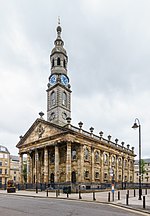The World Pipe Band Championships is a pipe band competition held in Glasgow, Scotland. The World Pipe Band Championships as we currently know them have been staged since 1947 although the Grade 1 Pipe Band Competition winners at the annual Cowal Highland Gathering were recognised as World Champions as far back as 1906. Although titled "The World Pipe Band Championship" this designation was made by the Royal Scottish Pipe Band Association (RSPBA) without consulting any other Pipe Band Association. Even though bands around the world compete the vast majority of bands that enter are from the United Kingdom. For competitive bands, the title of World Champion is highly coveted, and this event is seen as the culmination of a year's worth of preparation, rehearsal and practice. There are no qualifications to enter, bands do not have to enter or win any other competitions. The only requirement is the band is a member of the RSPBA or a Pipe Band Association recognized by the RSPBA
Until 2013, the entirety of the World Championships has taken place on one day in August, the current venue being Glasgow Green. Typically several hundred bands attend, traveling from all over the world. Competition commences at 9am.
Depending on the size of the grade - or in the case of Grade One, where a band has not secured automatic qualification - bands are required to perform in a qualifying round which takes place in the morning. The top bands at the end of the qualifying round play in a second event in the afternoon to determine the winner.
To win, Grade One bands must perform in two events, a March, Strathspey and Reel event (known as a "set" or "MSR") which consists of three pre-arranged tunes, and a Medley event, which consists of a short selection of music chosen and arranged by the band. The band must prepare two MSR sets and two Medley sets - and play one. This is drawn on the line.
However - from 2019 - the Grade 1 contest was adjusted so that the performances of bands on the Friday would now count. See: "New Format"
The title is currently held by the Field Marshal Montgomery Pipe Band from Northern Ireland.









